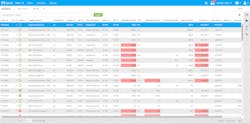After all the time, money and energy manufacturers have put into installing, maintaining and updating their enterprise resource planning (ERP) systems, interacting with this software should be a breeze. Unfortunately, due to customizations and upgrades, that’s often not the case. This makes for a troublesome operational environment when changes occur with customer orders and scheduling.
Keeping the manufacturers’ needs in mind, QAD has been on a multi-year mission to make ERP an adaptable enterprise-wide program that is role-based and inherently easy to use. In 2015, the company unveiled the first phase of its Channel Islands Project, an initiative that would give users of the QAD Cloud ERP access to an effective, device-independent user experience (UX) for sales order processing, requisition approvals, dashboards and event-based collaborative business activity. To achieve this, QAD underwent a complete rewrite of the underlying ERP architecture using standardized application program interfaces (APIs).
Last year, phase two—called “Santa Cruz”—rolled out, which included an activity feed for conversations in the system around such things as customer or supplier orders or invoices. At that time, role-based dashboards with real-time metrics were also introduced along with mobile capabilities around requisition approvals and other functions.
This month, QAD will present phase three of the Channel Islands Project, dubbed “Santa Rosa,” along with deeper vertical industry focus and compliance capabilities that track country and local regulations for financial reporting and taxation purposes.
According to Bill Keese, senior vice president of R&D for QAD, the major focus of this release is on usability and mobility (with backward compatibility). To that end, the business drivers behind the Cloud ERP initiative is to, first, give real-time insight to customers to help them make informed decisions. Second, there is a collaboration framework that directly links decisions to keep the system running efficiently. In addition, QAD has added a non-structured history to the ERP system so that if an issue occurred with a supplier or a customer a year ago, that information is accessible.
An important capability of Santa Rosa is that it provides executive-level visibility throughout the organization. “In the past, ERP has been a great record-keeping system, but executives don’t use ERP on a regular basis,” said Keese. “We give them access to get real-time insights and analytics,” as business intelligence is built-in and available on any device.
Also available in Santa Rosa is the ability to do a sales quote on the road via a service/support module. The addition of a process called ‘action request’ enables a customer service or sales rep to gather information and assign a task to someone else or initiate the creation of a service order—all happening as fluidly and quickly as possible.
From a supply chain perspective, new vendor management functionality via the QAD Supplier Portal adds collaboration and mobile access capabilities as well as an enhanced mobile global requisition system.
So, why is this important? “It makes [everyone’s] job easier,” Keese said. “The Channel Island Project is a four-year program. Every year we add more foundational capabilities or functionality. Last year until now, the focus has been on actionable insights for decision-making on the customer side and purchasing side. The second half of this year and the next focus will be on finance and enterprise application management, exposing more and more for a full suite of technology.”
There are, however, key enhancements in the finance and the enterprise asset management (EAM) areas in this version, as well. In addition to the user experience updates, QAD added support for revenue recognition changes mandated by ASC 606 and IFRS 15 guidance. The QADI19program, which tracks country and local regulations for financial reporting and taxation purposes to help keep customers in compliance, adds eight new country updates. QAD supports 60 countries and offers special country extensions for many more. And a new version of EAM adds vertical-specific capabilities and introduces a maintenance manager dashboard that allows customers to track and analyze maintenance performance indicators in real time, enabling them to react quickly as issues arise to improve preventative maintenance.
The update to the vertical focus is interesting in that, for nearly four decades, QAD has met the distinct needs of manufacturers in six industries: automotive, consumer products, food and beverage, high tech, industrial and life sciences. Recognizing that each of those six industries is composed of distinct types of manufacturers, QAD has refined its solution design to address the unique needs of each of these types of manufacturers. QAD now offers a distinct solution for 24 vertical segments within those six industries.
“The reality is that there is a great deal of segmentation within our six focus industries,” said Anton Chilton, QAD’s chief, global field operations. “For example, within the food and beverage industry, candy and confectionary manufacturers face different challenges than those encountered by manufacturers of frozen foods. Each of the 24 vertical segments that we’ve identified face unique challenges in technology, competition, regulation and the business processes we address through our solutions.”
QAD chief marketing officer Carter Lloyds added that this approach is a direct result of customer feedback. “Customers want us to be more prescriptive. They want to focus on actionable differences between segments that are more specific in terms of key performance indicators that are relevant and provide enhancements to business processes that are backed by the software. This is important to us because it is about people, process and technology.”
Available now, QAD will launch and demonstrate Santa Rosa next month at its customer conference in Detroit.
About the Author
Stephanie Neil
Editor-in-Chief, OEM Magazine

Leaders relevant to this article:
